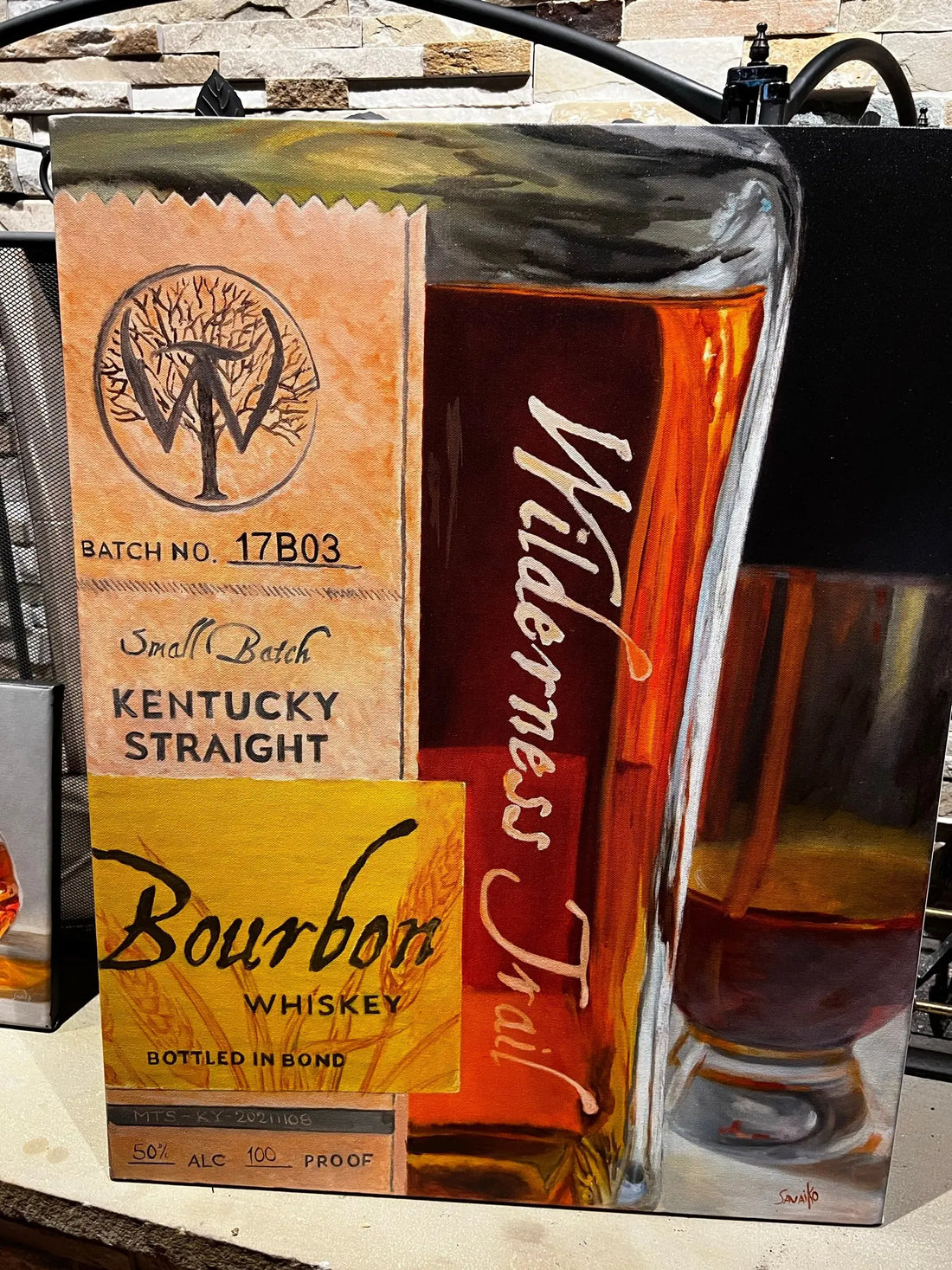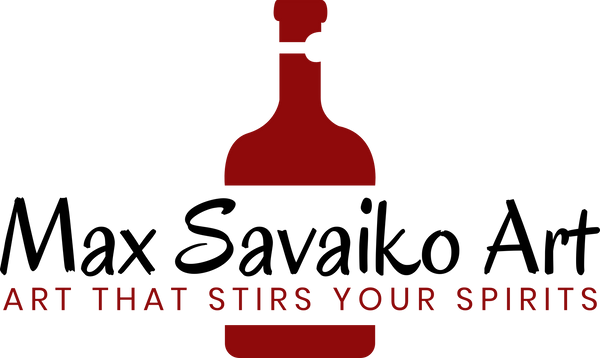
Prozessfotos für Wilderness Trail Bourbon Art
Aktie
Wilderness Trail Bourbon – Die Reise zur Wilderness Trail Destillerie
Von Max Savaiko
In diesem ausführlichen Blog geht es um das Bourbon-Gemälde vom Wilderness Trail und die Erfahrungen bei einem Auftrag für die Wilderness Trail Distillery .
Vor ungefähr einem Jahr habe ich auf Facebook ein Gemälde eines Heaven Hill-Bourbon-Whiskys gepostet, der in einer Flasche abgefüllt ist. Jemand hat mich kontaktiert und wollte, dass ich seine Lieblingsflasche male, also habe ich gesagt, klar, warum nicht? Ich habe ein paar Wochen lang eine Antwort bekommen, als ich dachte, ich wäre geghostet worden ... schon wieder.
Dann bekam ich eines Tages eine weitere SMS und einen weiteren Anruf, es war Pat Heist (Miteigentümer der Wilderness Trail Distillery). Nach einiger Diskussion fanden wir heraus, dass die Wilderness Trail Wheated Bourbon-Flasche, das Wilderness Trail Single Barrel und der Wilderness Trail Rye eine tolle Bourbon-Wanddekoration und tolle Gemälde für ihn und die Destillerie abgeben würden. Hier sind die Prozessfotos und Videos von dieser Erfahrung bei der Erstellung der legendären Bourbon-Gemälde.
Beginnen Sie mit dem Konzept - einer Nahaufnahme der Flasche. Lieben Sie die Farben und Details des Etiketts
Auf einer Reise voller Whisky und Kunst fand ich mich kürzlich in der berühmten Wilderness Trail Distillery im Herzen des Kentucky Bourbon Trail wieder. Diese Expedition war kein gewöhnlicher Besuch; es war eine Gelegenheit, niemand anderem als Dr. Pat Heist, dem Visionär hinter dem außergewöhnlichen Wilderness Trail Bourbon, ein Auftragsgemälde zu überreichen.

Die charismatische Atmosphäre der Brennerei: Eingebettet in die malerische Landschaft von Kentucky empfing mich die Brennerei mit offenen Armen. Der rustikale Charme der Umgebung spiegelte die Authentizität des Bourbon-Herstellungsprozesses von Wilderness Trail wider. Von den ausgedehnten Gerstenfeldern bis zu den sorgfältig gefertigten Eichenfässern schien jedes Detail der Geschichte dieses geschichtsträchtigen Bourbons Leben einzuhauchen.
Block- und Hintergrundfarben für Verglasungen
Der Prozess des „More Glazing“ ist eine Maltechnik, bei der Schichten durchscheinender Farben über eine vorhandene trockene Schicht aufgetragen werden, um im endgültigen Kunstwerk Tiefe, Leuchtkraft und einen leuchtenden Effekt zu erzeugen. Bei dieser Methode werden mehrere Schichten dünner Glasuren aufgetragen, sodass Licht durch die transparenten Pigmente dringen und mit den darunter liegenden Schichten interagieren kann. Das Ergebnis ist ein reichhaltiges und lebendiges visuelles Erlebnis, das die Gesamtleuchtkraft und Intensität der Farben verstärkt.
Hier ist eine Schritt-für-Schritt-Beschreibung des Glasurprozesses:
Vorbereitung der Leinwand:
Beginnen Sie mit einer grundierten Leinwand oder Oberfläche. Die Leinwand sollte trocken und bereit für den Auftrag von Lasurschichten sein.
Grundschicht: Tragen Sie eine erste Farbschicht als Basis auf. Diese Schicht dient als Grundlage für die nachfolgenden Lasuren. Lassen Sie sie vollständig trocknen, bevor Sie mit dem Lasieren fortfahren.
Auswahl durchscheinender Farben: Wählen Sie eine Palette durchscheinender oder halbtransparenter Farben. Diese Farben lassen Licht durch und erzeugen beim Auftragen mehrerer Schichten einen leuchtenden Effekt.
Verdünnen der Farbe: Verdünnen Sie die ausgewählten Farben mit einem Lasurmedium oder einem klaren Acrylmedium. Dadurch wird sichergestellt, dass die Lasuren transparent sind und die darunter liegenden Schichten nicht verdecken. Das Verhältnis von Farbe zu Medium hängt von der gewünschten Transparenz und den spezifischen Eigenschaften der verwendeten Farbe ab.

Mehr Glasuren mit Farben, die durch das Kunstwerk hindurch leuchten
Auftragen von Glasuren: Tragen Sie mit einem weichen Pinsel eine dünne Schicht der verdünnten Farbe auf die trockene Grundschicht auf. Wichtig ist, die Glasur gleichmäßig aufzutragen und dicke, undurchsichtige Schichten zu vermeiden. Lassen Sie jede Schicht trocknen, bevor Sie die nächste auftragen.
Untermalung: Bevor Künstler Lasuren auftragen, beginnen sie oft mit einer Untermalung. Diese erste Schicht dient als Grundlage und hilft, den Ton für das Kunstwerk festzulegen. Die Untermalung kann monochromatisch sein oder aus einfachen Farbblöcken bestehen und als Leitfaden für die nachfolgenden Lasuren dienen.
Farbauswahl: Die Auswahl der Farben für die Lasur ist entscheidend. Künstler entscheiden sich oft für transparente oder halbtransparente Pigmente, um das Eindringen von Licht zu ermöglichen. Erdtöne wie gebrannte Siena oder Umbra werden häufig für die Untermalung verwendet, während für die Lasur leuchtende und transparente Farben gewählt werden, um einen leuchtenden Effekt zu erzielen.\Medien
Glasurmedium:
Künstler mischen ihre ausgewählten Farben mit einem Lasurmittel. Dieses Mittel dient mehreren Zwecken: Es verdünnt die Farbe für mehr Transparenz, verlängert die Trocknungszeit und verbessert den Farbfluss. Die Wahl des Lasurmittels kann das endgültige Aussehen der Lasuren beeinflussen.
Schichttechnik:
Lasieren ist eine Schichttechnik, bei der jede weitere Schicht aufgetragen wird, nachdem die vorherige vollständig getrocknet ist. Dieser Schichtprozess sorgt für Tiefe und Intensität. Künstler berücksichtigen die Reihenfolge der Farben und die Wirkung jeder Schicht auf die Gesamtkomposition sorgfältig.
Pinselauswahl: Weiche Pinsel mit feinen Borsten werden oft zum Lasieren bevorzugt. Diese Pinsel ermöglichen ein gleichmäßiges Auftragen, ohne sichtbare Pinselstriche zu hinterlassen. Ein sanfter Strich ist entscheidend, um die darunter liegenden Schichten nicht zu beschädigen.
Kontrolliertes Auftragen: Künstler kontrollieren das Auftragen von Glasuren, indem sie den Druck und die Richtung ihrer Pinselstriche variieren. Diese Kontrolle ist wichtig, um einen nahtlosen Übergang zwischen den Schichten zu erreichen und die Transparenz der Glasuren beizubehalten.
Trocknungszeit
Geduld ist beim Glasurverfahren der Schlüssel. Jede Schicht muss ausreichend lange trocknen, bevor die nächste aufgetragen werden kann. Schnelles Trocknen kann zu einer weniger effektiven Glasur führen, während längere Trocknungszeiten ein gezielteres Auftragen der Schichten ermöglichen.
Farbintensität anpassen: Der Künstler hat die Flexibilität, die Intensität der Farben anzupassen, indem er die Anzahl der Lasurschichten variiert. Mehr Schichten intensivieren die Farbe, während weniger Schichten subtilere Effekte erzeugen. Diese Flexibilität ermöglicht es dem Künstler, die gewünschte Stimmung und Atmosphäre im Gemälde zu erzielen.
Gebäudeebenen
Wiederholen Sie den Vorgang, indem Sie weitere Schichten Glasur auftragen. Mit jeder Schicht beginnen sich die Farben aufzubauen, wodurch ein Gefühl von Tiefe und Komplexität entsteht. Die vorherigen Schichten werden subtil durchscheinen und die Leuchtkraft des Kunstwerks verstärken.
Erstellen von Lichtern und Schatten
Passen Sie die Intensität der Glasuren an, um Glanzlichter und Schatten zu erzeugen. Die Schichtung durchscheinender Farben ermöglicht ein nuanciertes Zusammenspiel von Licht und Schatten und trägt zum insgesamt leuchtenden Effekt bei.
Feinabstimmung und Detaillierung
Während sich die Schichten anhäufen, können Künstler Details feinabstimmen, Kontraste verstärken und die Komposition verfeinern. Der Lasurprozess ermöglicht eine feine Herangehensweise an Details, während die leuchtende Qualität der Farben erhalten bleibt.

Schlusslackierung:
Sobald das Gemälde fertig ist und alle Schichten vollständig getrocknet sind, kann ein Schlussfirnis aufgetragen werden, um das Kunstwerk zu schützen und seine Leuchtkraft weiter zu verbessern.
Die „More Glazing“-Technik erfordert Geduld und ein ausgeprägtes Verständnis der Farbtheorie. Künstler, die diese Methode verwenden, finden sie oft eine effektive Möglichkeit, visuell beeindruckende und ätherische Effekte in ihren Gemälden zu erzeugen, bei denen die Farben nicht nur auf der Oberfläche existieren, sondern aus dem Inneren des Kunstwerks heraus strahlen und leuchten. Ich liebe diesen Prozess, auch wenn er zeitaufwändig ist, das Endprodukt ist es wert. Siehe unten
Endprodukt – Bereit für den Trail

Die große Enthüllung: Als der Moment der Offenbarung näher rückte, herrschte im Verkostungsraum der Wilderness Trail Distillery eine freudige Aufregung. Dr. Pat Heist, ein Meister der Bourbon-Welt, erwartete die Enthüllung mit einer Mischung aus Neugier und Vorfreude. Max Savaiko, der seine Kreation mit einer Mischung aus Stolz und Demut trug, trat vor, um die Kunst zu enthüllen, die zu einem Herzensprojekt geworden war.
Das in warmes Licht getauchte Gemälde enthüllte sich einem Publikum, das kollektiv den Atem anhielt. Stille breitete sich im Raum aus, als die leuchtenden Farben und komplizierten Details des Kunstwerks sichtbar wurden. Die Leinwand sprach und erzählte die Geschichte des Wilderness Trail durch Max Savaikos künstlerische Linse.
Dr. Pat Heists Reaktion: Dr. Pat Heist, ein Mann, der eng mit der Destillerie verbunden ist, stand wie gebannt da. Seine Augen folgten den Konturen des Gemäldes und nahmen jede Nuance und jedes Detail auf. Im Raum hallte die stille, aber tiefe Wertschätzung wider, die nur ein Künstler und ein Kenner von Bourbon teilen kann. Es war ein Moment, eingefroren in der Zeit, in dem die Schöpfung auf ihre Muse traf und sich die Essenz von Wilderness Trail in Pinselstrichen manifestierte.
Eine gemeinsame Verbindung
Das Gemälde fängt nicht nur die Essenz von Wilderness Trail ein, sondern spiegelt auch das gemeinsame Ethos von Max Savaiko und Dr. Pat Heist wider. Es ist ein Beweis für die Hingabe, Leidenschaft und Innovation, die sowohl den Künstler als auch den Destillateur auszeichnet. Die Leinwand wird zu einer Brücke, die die Welten von Kunst und Bourbon verbindet und eine Verbindung herstellt, die über den physischen Raum der Destillerie hinausgeht.
Die Details erkunden
Als die anfängliche Ehrfurcht nachließ, beschäftigte sich Dr. Pat Heist mit Max Savaiko und erkundete die Details des Gemäldes. Jeder Strich schien ein anderes Kapitel der Geschichte der Wilderness Trail-Destillerie zu erzählen – von den sorgfältig ausgewählten Körnern bis hin zur Kunstfertigkeit bei der Herstellung der Fässer. Das Gemälde war nicht nur ein Kunstwerk; es war eine Einladung, tiefer in die Nuancen des Bourbon-Herstellungsprozesses einzutauchen.
Ein Toast auf Kunst und Bourbon
Nach der Enthüllung wurde die Feier mit einer Verkostung der besten Bourbons von Wilderness Trail fortgesetzt. Wir erhoben unsere Gläser zum Anstoßen auf die künstlerische Zusammenarbeit, die sich vor unseren Augen entwickelt hatte. Max Savaiko und Dr. Pat Heist erzählten Geschichten, sprachen über ihre Erkenntnisse und lachten miteinander, wodurch eine Verbindung entstand, die im Feuer der Kreativität und Leidenschaft geschmiedet wurde.
Abschluss
Die Vorstellung von Wilderness Trail Bourbon Art durch Max Savaiko vor Dr. Pat Heist war ein unvergessliches Kapitel in der Geschichte der Brennerei. Es war ein Moment, in dem zwei Welten zusammentrafen – die Welt der Kunst und die Welt des Bourbons.
Max Savaikos Bourbon-Wanddekor ziert jetzt die Brennerei und ist ein lebendiges Zeugnis der gemeinsamen Hingabe und Handwerkskunst, die Wilderness Trail auszeichnen.
Als die Sonne hinter dem Horizont von Kentucky verschwand, blieben die Echos dieser künstlerischen Offenbarung bestehen und schufen ein Vermächtnis, das über Leinwand und Fass hinausgeht.
